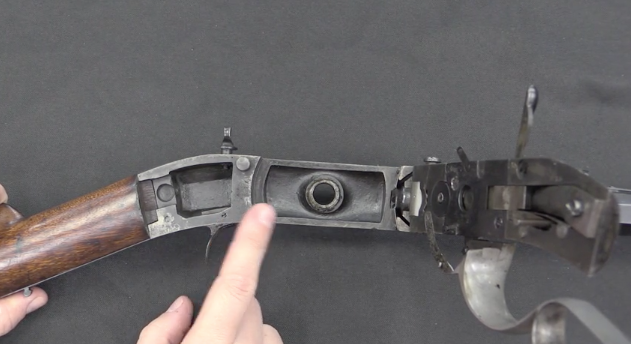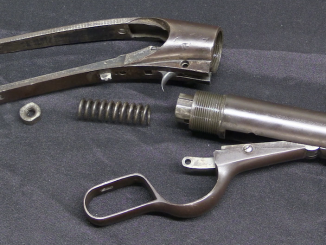After the problems with the Colt XM-148 under barrel grenade launcher were discovered in service in Vietnam, the US military was eager to quickly find a better alternative. The idea of replacing the standalone M79 grenade launcher with an under barrel unit was very appealing, and the development program moved quickly. Of seven different designs considered, AAI was the best, and it was adopted as the M203 and put into the field by 1969.
The M203 was a dramatic improvement over the XM148, with much simpler controls and batter handling. It would be made in large quantity (over a quarter million) and used until replaced only recently by the HK 320 launcher.
Many thanks to Movie Armaments Group in Toronto for the opportunity to showcase this grenade launcher for you! Check them out on Instagram to see many of the guns in their extensive collection.




More recent service guys please fill me in, I get the impression the M320 has a shorter range than the M203 and certainly the M79. What is the long , unofficial range of this weapon?
A bit disappointed Ian didn’t go into the rifle barrel profile required (which affected the shape of later military “heavy barrel” rifles), launcher disassembly, the handguard, front sling swivel … all minor points of course. The other very common round for the M203: chalk-filled training rounds.
Ian didn’t mention the mid-weight 40mm grenades that have extended range, and which can still be fired from the hand-held weapons.
The standard grenade is 40X46; the big boy from the AGL weapons is 40X53, and the mid-level load is 40X51. Try firing a 40X53 out of an M203, and you’re going to need a new shoulder; the 40X51 is (barely) fireable out of the handheld launchers, giving you extended range and payload.
“(…)40X53 out of an M203, and you’re going to need a new shoulder; the 40X51 is (barely) fireable out of the handheld launchers(…)”
Looking at numbers these seems dangerously similar (easy to mistake). Did they have any visual or tactile means of differentiating them.
“(…) 40X46(…)”
To enhance confusion one of WarPact member used 40x47SR ammunition, not compatible with 40×46 NATO: https://modernfirearms.net/en/grenade-launchers/poland-grenade-launchers/pallad-eng/
You can’t fire 40X53 out of an M203. The Army realized the danger of exploding M79’s
so the “high velocity” round fired from the M75 used in helicopter gunships was designed so as to not fit in the hand carried weapon.
https://en.wikipedia.org/wiki/M75_grenade_launcher
“There are two main types in service with NATO countries: the 40×46mm,[2] which is a low-velocity round used in hand-held grenade launchers; and the high-velocity 40×53mm, used in mounted and crew-served weapons. The cartridges are not interchangeable.”
FWIW: The M203 was standardized August 29, 1969 with AAI receiving a ~$2,953,000 sole-source production contract for 10,000 M203. The contract’s estimated date of completion was December 1970; however, funding actions were still awarded until June 1973.
To facilitate future second-source contracting, the US Army also purchased limited license rights as well as the M203’s technical data package. Undoubtedly, AAI still received royalty fees off of Colt’s production for the next several years.
Also, Philco-Ford was the aerospace business division of Ford Motor Company. Several years earlier, Ford had bought the Philco Corporation and folded it together with their own Aeronutronic Systems. The exact name of the aerospace division changed up every few years.
The M79 was still in use when I was in RVN in 1970.
I carried an M203 in the Invasion of Iraq in 2003-2004. It was made by LMT (Lewis Machine and Tool) and was mounted on an M16A2 rifle. I loved it and the extra little bit of firepower it provided. I was issued HE grenades, and also parachute illumination flares, red and green starshell cluster flares, and red and green smoke marking rounds. In practice we used HE for everything, though it was not unheard of to use a flare or smoke round direct fire if it happened to be what you had loaded at the time. The leaf sight stayed on the rifle, though as Ian pointed out, we almost never actually used the sights. The quad sight was removed and “lost” before the war even began. Overall I was very happy with the weapon, it served me well.
In 68’/69′ Nam we had HE, shotgun and tear gas. No, most of the 79ers did not use sights.
“Say hello to my little friend!” Bang! Guess who said that line…
Every college frat boy the first time he got a chick naked?
What did I win?
“A boot to the head!”
Colt Canada makes now (I suppose on intermittent order) EAGLE – 40x46mm side-loader. https://www.coltcanada.com/phone/e.a.g.l.e.html
I had ‘something’ to do with it many years ago 🙂
I have got to stop watching Forgotten Weapons while driving.
In 2004 during mob up at Hood we had 28 M203 off rifle and were waiting for 1099th DS to come up with the QD kits for the Entire 256th BCT. We had a M203 range in 3 days, Instead I mounted them on our M4’s by turning the front collar piece 180 deg and bending the finger down to meet the bbl. I used AN/PVS-4 QD rail mount brackets to make Ladder sights using 1/4-20 panhead screws from the motor pool and the old indirect sight
CAPT Flynn was happy since we turned out to be the only unit in the Bde with a sighting system come range day and the gunners told me the sights worked great. BDE never did get enough QD mount kits
Just fyi, the Mk 19 belt-fed 40mm machinegun is not locked breech, but a giant belt-fed blowback submachinegun mechanism. When you take it apart to clean for the first time you realize this is just a giant aluminum STEN.
An interesting overview. Can we look forward to a look at the heavier belt types and the Russian (and perhaps other) counterparts?
There are many different designs of AGLs worldwide. For instance, China had done huge progress in that category. As far as Russian AGLs, they tend to be lot less massive that those made in the U.S. for single reason: to be portable.
https://www.youtube.com/watch?v=Eb6HIV5TW5Y
These launchers tend to be bit on “flashy” side due to their lightweight design (one reason they are called Plamya = Flame). They employ advanced priming using L-arm which trips firing pin just before round is seated. They work, but their operational margin is not wide. Just like everything in firearms, it is a matter of acceptable compromise.
I will substitute for omni-present Daweo, today conspicuously missing 🙂
One more important thing about Russian grenade launchers – they are using caseless ammunition thus there are no casing ejection issues. The Russian grenades are 30mm in diameter which is making them more aerodynamic during flight; the payload is made up by greater length. Definitely a thoughtful design since they are interchangeable with some hand held types, as you can see in clip.
“(…)missing(…)”
And this allow you hoax spawning?
AGS-17 (and AGS-30) are using 30 mm ammunition, which definitely is not case-less. See Vaina de acero lacado here: http://municion.org/30mm/30x29Ags.htm
“(…)hand held types(…)”
Baryshev developed such weapon for 30×29 B ammunition, it was one weapon in his line-up
https://guns.fandom.com/wiki/Baryshev_weapon_family
“(…)caseless(…)”
Such ammunition is used in GP-25 (underbarrel), its derivatives and some other han-held grenade launcher. There was also developed another case-less ammunition for grenade launcher – namely 7P39 for:
https://modernfirearms.net/en/grenade-launchers/russia-grenade-launchers/balkan-eng/
this weapon was tested and demonstrated few years ago, I do not encountered information of its later fact.
Yeah, you are correct… of course. I realised my error after I was done. The machine-launchers do have short, stubby cases, but they are not case-less.
“(…)thoughtful design(…)”
Well, AGS-17 was designed by team of designers of ОКБ-16. Among them was A.A.Richter. I believe all his and co-designed by him were well though, although he mainly worked with aviation weapon:
https://ru.wikipedia.org/wiki/%D0%A0%D0%B8%D1%85%D1%82%D0%B5%D1%80,_%D0%90%D1%80%D0%BE%D0%BD_%D0%90%D0%B1%D1%80%D0%B0%D0%BC%D0%BE%D0%B2%D0%B8%D1%87
“(…)HK 320 launcher(…)”
Lets see:
XM148 – single-shot
M203 – single-shot
320 – single-shot
Requirements regarding grenade-launching part of SALVO: 3-shot, self-loading, weight limit (completely loaded both parts): 4,54 kg
https://modernfirearms.net/en/assault-rifles/u-s-a-assault-rifles/spiw-eng/
hmm… who was responsible for that requirements?
Blame US Army Ordnance Corps for that abomination of development!
During the Salvadoran Civil War, 1980-1992, some sort of single-shot “M26” grenade launcher was found in use by the FMLN guerrillas–thought to have Cuban provenance. Obviously the Salvadoran armed forces had both M79s and M203s in roughly equal numbers using U.S. 40mm grenades.
Can anyone scroll down and look at this supposed “12.7mm rifle ‘can~on’?”
https://www.soc.mil/ARSOF_History/articles/v2n1_artefactos_explosivos_page_1.html
Is that actually some sort of workshop-mfr. “China Lake” type pump action grenade launcher? I ask, because the rounds pictured don’t really look the 12.7x108mm cartridges used by the Hind helicopter, but more like some sort of grenade? Any ideas?
30x29Bmm yes?
“30x29B”
Yes, these seems to be that ammunition.
“Any ideas?”
Hind-D was armed with 4-barrel rotary machine gun YakB-12,7
I am not sure how viable is using part of it for building 30 mm repeating grenade launcher.
Right. That was my point. Supposedly the breech mechanism was used, but I just don’t know. I thought that these were 30x29Bmm grenades, which ostensibly are what was used for the M26 grenade launcher–wherever that came from. Seems like the 40x46mm would have been a candidate, perhaps?
In any case, there was a pump-action 40mm grenade launcher that was tried out by U.S. forces during the Vietnam War, called the “China Lake.” I think the only info most North Americans have about it is from “first person shooter” video games, namely the “Call of Duty” franchise?
In this case, it looks like a Salvadoran guerrillero knock-off: a pump-action weapon with Soviet type 30x29Bmm grenades? Looks like a misidentification in the essay.
“(…)pump-action(…)”
Due to its size it somewhat resemble KS-23, though I do not know if this weapon was known to Salvadorans in 1980s.